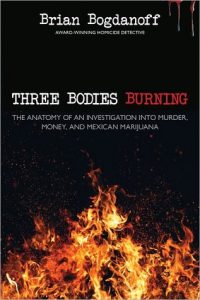PUBLISHED DECEMBER 2017
by Sandra Wendel, Author and Editor --

Sandra Wendel
When prospective authors ask me what it will take to edit their manuscripts, I think back to one particular story, and I say: “Whatever it takes to get your story out of your head and into print.” Sometimes it takes a lot more than commas and quotation marks. Here’s how one manuscript evolved into an award-winning book.
After working his way up through the ranks in narcotics and homicide, putting plenty of bad guys in prison, and retiring from exemplary work on the Omaha Police Department, detective Brian Bogdanoff sat down to write a story he titled:
Three Bodies Burning: The Anatomy of an Investigation into Murder, Money, and Mexican Marijuana.
He had pursued the murderers for two years before the case that haunts every detective (this was his) was finally solved. Two gangbangers were in prison for life after ripping off tons of weed and leaving three Mexican drug cartel minions dead, their bodies dumped and burned along a wooded, rural roadside in Omaha.
This true-crime tale unfolded like fiction. It was
CSI meets
Law and Order, with a dramatic courtroom scene when the cops piled bales of marijuana (evidence) next to the jury box, much to the horror of the judge and jurors (apparently the smell was overwhelming).
Brian and I met in a book-writing class I was teaching at the community college. The manuscript he brought me read like a police report with words like “vehicles,” “perpetrators,” and "victims." So I invited him to my home office, sat him down, and we began.
He had written:
As I spoke with each of them separately, I could see nobody wanted to talk yet, so I made it very clear to Preston and Gaylan that I was a homicide detective, not a narcotics officer, and this case that brought me to them was just getting started.
As if he were on the hot seat in an interrogation room, I grilled him: “What did Gaylan look like?” “What was he doing?” “What exactly did he say?” “And then what did you say?” “Describe the room—how big, furniture, what?"
Here’s the revision of the same passage:
Gaylan was first. If someone was going to talk, I thought it would be Gaylan.
I walked into a fourth-floor interview room of the Criminal Investigation Bureau at downtown police headquarters. Gaylan was sitting at the same table where he’d been sitting for nine hours while we were searching his house, the recording studio, the lawn service, the remaining storage units, and his secondary houses.
His head was down, he looked up at me and said, “What’s up, man?”
He’s a big guy, twenty-four years old, and was tired from sitting in a ten-by-ten room all day. He wasn’t handcuffed, but there was a guard outside the door.
“You got big problems.” I opened the conversation. “I got a receipt and inventory of all the stuff we recovered today, and it doesn’t look good.” I handed him a list of the property seized.
“I’m a homicide cop, and that’s what this is all about, so you might be in your best position right now to tell me what you know,” I said. “If someone else wants to talk first, they’ll get all the good things that come with it.” And he chose not to talk.
I gave the same spiel to Preston. He had the same attitude. He wasn’t talking.
Roscoe and I then walked Gaylan to the jail elevator and rode it to the basement of the police station. We put our guns in the gun locker and walked him into jail. He was booked in for his marijuana charges and taken to his concrete ten-by-ten cell in solitary confinement, which on the street has earned the name Bedrock.
We did the same procedure for Preston.

Three Bodies Burning by Brian Bogdanoff
And the story came out, excruciating detail by detail, so readers could go inside the mind of this talented detective and follow his story from crime scene to courtroom, gasping when blood was found under the carpet of a home, unbeknownst even to the current residents. Readers followed the thread of a note found in the pocket of one of the burned bodies to the hotel where the cartel guys stayed.
We described more key scenes with fresh detail and dialogue. And then we went to the crime scenes themselves where I took photos of the roadside burn site where religious artifacts had still been left presumably by grieving family five years later; to the yellow house where the gangbangers shot the Mexicans and loaded their bodies into a pickup that left a dripping blood trail down the street; to the neighborhood where the bangers lived that didn’t feel safe even at two in the afternoon with an armed police officer giving the guided tour.
We gathered yet more detail, so I could add pertinent facts and observations. That’s what an editor does.
Sandra Wendel edits nonfiction—primarily memoir, true crime, business/leadership, and self-help. She teaches classes on how to write a book at Metropolitan Community College in Omaha and is the co-author of the award-winning How Not to Be My Patient,
written with Mayo Clinic doctor, Edward T. Creagan, MD. Contact her at SandraWendel.com.